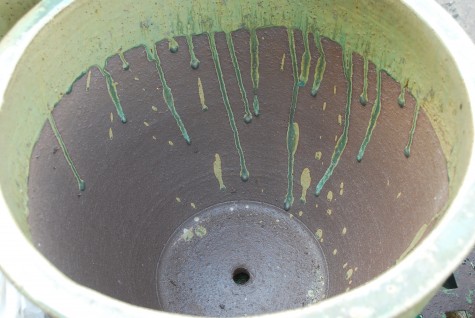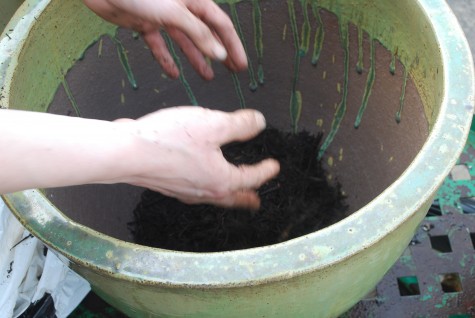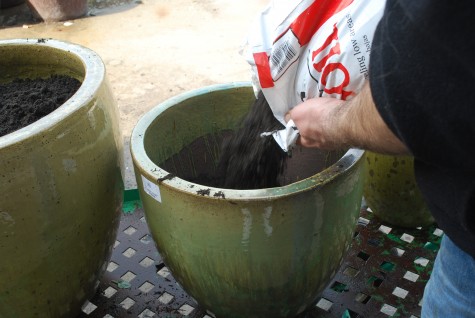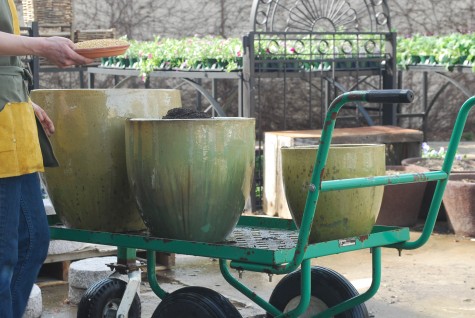 I happily buy pots from Nancy LaMotte. Her firm, Anamese Garden and Home, which is based based in Louisiana, designs beautiful glazed pots which are made in Vietnam. The shapes are beautiful; the construction is superb. She asked if I would write an essay about planting pots for her newsletter. Why not? As I am ready to post a tutorial or two about my methodology for planting containers, I am happy to plant a trio of her pots. How beautiful they are; these glaze drips running over the interior terra cotta surface are a preview of what is to come.
I happily buy pots from Nancy LaMotte. Her firm, Anamese Garden and Home, which is based based in Louisiana, designs beautiful glazed pots which are made in Vietnam. The shapes are beautiful; the construction is superb. She asked if I would write an essay about planting pots for her newsletter. Why not? As I am ready to post a tutorial or two about my methodology for planting containers, I am happy to plant a trio of her pots. How beautiful they are; these glaze drips running over the interior terra cotta surface are a preview of what is to come.
 Successful container planting is much about the dirt, and the drainage of that dirt. Once you have chosen a beautiful pot, container, or urn-what stacks up on the inside has much to do with a planting living up to the beauty of its home. Number one for me-insuring good drainage. I fill every pot at least one-third full, maybe more, with a porous well draining material. Coarse gravel, bark, terra cotta shards, cell pack plastic liners-a thriving pot planting drains instantly. A layer of non-woven landscape fabric will keep your soil from sifting down into, and plugging, the drainage material. Most plants love regular and reliable water, but they hate sitting in it.
Successful container planting is much about the dirt, and the drainage of that dirt. Once you have chosen a beautiful pot, container, or urn-what stacks up on the inside has much to do with a planting living up to the beauty of its home. Number one for me-insuring good drainage. I fill every pot at least one-third full, maybe more, with a porous well draining material. Coarse gravel, bark, terra cotta shards, cell pack plastic liners-a thriving pot planting drains instantly. A layer of non-woven landscape fabric will keep your soil from sifting down into, and plugging, the drainage material. Most plants love regular and reliable water, but they hate sitting in it.
 Perhaps even more important-the soil. Every gardener has a mix-I am no exception. I like a heavy soil, leavened with lots of compost and a big dollop of sand. Though plenty of garden centers sell giant bags of peat based “planting media”, I am a fan of topsoil. As in the closest thing to good garden dirt that is available.Peat based plant mixes are light-you can carry a giant bag to your car. But peat based planting media implies a professional grower on the other end who will feed that sterile soil at whatever parts per million it needs to produce good plants. My dirty little secret-good and hefty soil is essential for great plantings. A compost based soil that does not dry out too fast, that has nutrients, is perfect for garden variety gardeners. I am no fan of hauling forty pound bags of soil around-so I farm that job out to whomever I can persuade to help me. This is worth the trouble-making sure the pots get filled with great soil.
Perhaps even more important-the soil. Every gardener has a mix-I am no exception. I like a heavy soil, leavened with lots of compost and a big dollop of sand. Though plenty of garden centers sell giant bags of peat based “planting media”, I am a fan of topsoil. As in the closest thing to good garden dirt that is available.Peat based plant mixes are light-you can carry a giant bag to your car. But peat based planting media implies a professional grower on the other end who will feed that sterile soil at whatever parts per million it needs to produce good plants. My dirty little secret-good and hefty soil is essential for great plantings. A compost based soil that does not dry out too fast, that has nutrients, is perfect for garden variety gardeners. I am no fan of hauling forty pound bags of soil around-so I farm that job out to whomever I can persuade to help me. This is worth the trouble-making sure the pots get filled with great soil.
 I topdress my soil with Osmocote, a time release fertilizer. A small amount gets released, or osmoses through the wall of the granule, immediately. The rest will release over time in response to temperature. The warmer the weather, and soil temperature, the faster the rate of release. The plants you buy at nurseries and farmer’s market’s are grown in fertilized soil, but at a certain point, the care and feeding will be up to you.
I topdress my soil with Osmocote, a time release fertilizer. A small amount gets released, or osmoses through the wall of the granule, immediately. The rest will release over time in response to temperature. The warmer the weather, and soil temperature, the faster the rate of release. The plants you buy at nurseries and farmer’s market’s are grown in fertilized soil, but at a certain point, the care and feeding will be up to you.
 I mix the osmocote into the top 4-8 inches of soil-this is an essential part of the process. Potted nursery stock that has osmocote on the surface-the person who applied that is very careful not to do too little, or too much. Too much feed is worse than no feed at all.
I mix the osmocote into the top 4-8 inches of soil-this is an essential part of the process. Potted nursery stock that has osmocote on the surface-the person who applied that is very careful not to do too little, or too much. Too much feed is worse than no feed at all.

These gorgeous pots are ready for some plants. How will I choose? Nancy calls this glaze “swamp”; this color has a lot of possibilities, does it not? The next essay-all about the sheer fun of planting a spring container.
Thanks for the information. I never thought about putting the landscape fabric between the filler and the soil. Seem so obvious now after reeding it. Looked like you used mulch as a filler?
I’m sure you will choose something gorgeous as usual.
For me, with colored pots, I usually like a color that contrast the pot or something that picks up a color in the pot.
Have fun creating! Can’t wait to see the result.